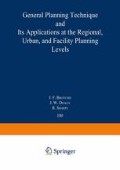Abstract
The record of useful application of models in urban and regional planning does not look very impressive if judged from recent literature. The rather spectacular failures of some large scale urban models are featured in review articles and some harsh statements have been made:
They are established without a single successful demonstration, they are tried everywhere and they do not work anywhere. They require theory that no one has and data no one can get. All claim to enhance societal learning, but none contain operative mechanisms for benefiting from their own mistakes (13.1).
Access this chapter
Tax calculation will be finalised at checkout
Purchases are for personal use only
Preview
Unable to display preview. Download preview PDF.
References
G. Brewer, “Politicians, Bureaucrats and the Consultant.” New York, 1973. A Review in Science, Vol. 182, No. 7119.
A. Karlqvist and L. Lundqvist, “A Contact Model for Spatial Allocation.” Regional Studies, Vol. 6, pp.401–18, 1972.
M. Batty, “Recent Developments in Activity Allocation Models in a British Context.” Urban Development Models. Construction Press, Hornby, England, 1974.
J. Rothenberg Pack, “The Use of Urban Models: Report on a Survey of Planning Organizations,” Journal of the American Institute of Planners, May, 19 75.
Melbourne and Metropolitan Board of Works, Planning Policies for the Melbourne and Metropolitan Regional and Amending Planning Schemes 3 and 21 , Melbourne, 1974.
State Planning Authority of N.S.W., Gosford-Wyong Strategy Plan , 19 7 3.
New South Wales Planning and Environment Commission, Gosford-Wyong Structure Plan , 1975.
J.F. Brotchie and R. Sharpe , “A General Land Use Allocation Model: Application to Australian Cities,” Urban Development Models. Construction Press, Hornby, England, 1974.
J.R. Roy and J.R. Crawford, An Urban Land-use Transportation Study in a Developing Country, CSIRO Division of Building Research Report (to be published).
Lawrence Nield & Partners, The Lismore Hospital Development, 1976.
Lawrence Nield & Partners, Canberra Hospital Study, 1979.
E. Teicholz, “The TOPAZ Urban and Planning Allocation Model.” Proc . PARC 79, International Conference on the Application of Computers in Architecture Building Design and Urban Planning, Berlin, Online-AMK Berlin, 1979.
Author information
Authors and Affiliations
Rights and permissions
Copyright information
© 1980 Springer-Verlag Berlin Heidelberg
About this chapter
Cite this chapter
Brotchie, J.F., Dickey, J.W., Sharpe, R. (1980). The use of Modelling in the Planning Process. In: Topaz. Lecture Notes in Economics and Mathematical Systems, vol 180. Springer, Berlin, Heidelberg. https://doi.org/10.1007/978-3-642-51574-3_13
Download citation
DOI: https://doi.org/10.1007/978-3-642-51574-3_13
Publisher Name: Springer, Berlin, Heidelberg
Print ISBN: 978-3-540-10020-1
Online ISBN: 978-3-642-51574-3
eBook Packages: Springer Book Archive

